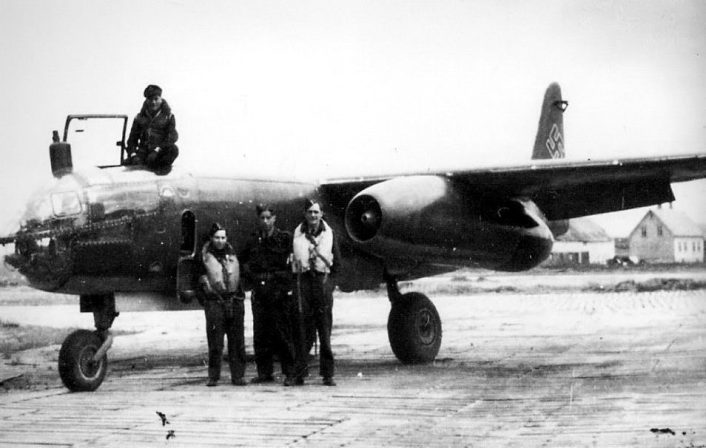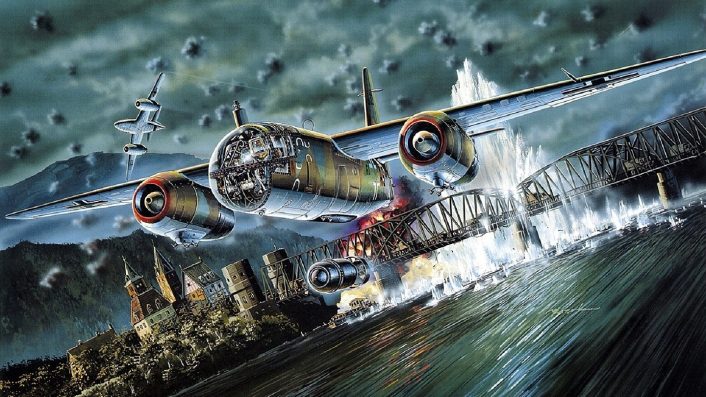The First Ever Jet Airstrike Was a Disaster. Here’s The Bizarre Story.
When gunners spot them, they are stunned: their speed. No propellers.
From out of the northeast, rocketing down from medium altitude in a shallow dive intended to improve bombing accuracy the Germans are back again. It is one more day of airstrikes on the prize. This is the third set of airstrikes today.
But this one is different. The planes are flying much faster. And have no propellers.
It’s March 1945 and the first jet airstrike in history has begun. German Arado Ar 234 medium bombers and Messerschmitt Me 262 fighter/attack jet aircraft are launching a last-ditch airstrike on this key target in a desperate attempt to halt the allied advance.
But it isn’t going well.
The Ludendorff Bridge at Remagen, Germany is the most heavily defended target from air attack ever. Since the allies seized the bridge in a lightning attack a few days ago around March 7th they have emplaced more anti-aircraft guns surrounding this key bridge than any other single target on earth. In the upcoming 10 days of the German Luftwaffe campaign against the Ludendorff Bridge approximately 367 combat aircraft will attack the target. The Germans throw everything at Ludendorff, fighters, bombers, frogmen, artillery and now the secret German super-weapons, the jet bombers and fighters. The Allies claim to shoot-down 30% of the German planes. None score an effective hit on the bridge.
Bridges are a notoriously difficult target to hit with fast jets. The Germans are learning this difficult lesson for the first time in history today. The U.S. Air Force relearns it years later between 1967 and 1972 during protracted (and largely ineffective) airstrikes on the Long Biên (“Paul Doumer”) Bridge. They finally develop a new secret weapon, a “guided bomb” directed to its target by a laser beam. The Americans destroyed the North Vietnamese bridge on the first try with laser-guided bombs in 1972.

The Germans have crude guided bombs now including the “Fritz” radio-guided dive-bomb, but neither the new Arado jet bombers nor the smaller Messerschmitt jets can carry the large Fritz guided “smart” bomb.
As the hours to seize the bridge from the Allies turn into days the Germans become increasingly desperate. Luftwaffe Chancellor Hermann Göring proposes a suicide attack with bomb-laden Me 262 jets. No volunteers come forward or a technical shortcoming of the aircraft’s aiming device- or both- prevents the desperate tactic.
Göring forms a secret, special unit named the “Gefechtsverband Kowalewski”. It is an elite cadre of handpicked, jet-qualified strike pilots from Kampfgeschwader 76, the 76th Bomber Wing formerly located in Norway. The first jet attack pilots in history.
On March 13 the Germans hurl 19 of the special Ar 234 medium bombers and 30 Messerschmitt Me 262 A-2a jet fighter-bombers from II Kampfgeschwader 51 against the target. They are led by special Luftwaffe jet pilot Hansgeorg Bätcher. Bätcher led a previous (unsuccessful) March 7th mission against the Ludendorff problem and lived to tell. He knew the target well. It takes a brave man to volunteer to return, but the German situation is increasingly desperate.

It will be the first all-jet airstrike on a ground target in aviation history. Even with a full complement of heavy 1,000kg bombs weighing more than a ton the bombers can press home the attack run at over 660 km/h (410 mph), a nearly unheard of speed at the time. They are so fast the American anti-aircraft units will have trouble hitting them. Speed is their primary defense. For six days the III Gruppe/KG 76 pilots attempt to hit the bridge in nine separate strikes.

Seated in the bubble nose of their incredibly fast Arado jet bombers the pilots have an excellent view. The sky is entirely aglow with bursting anti-aircraft shells, the thickest they have ever seen. Diving into the fiery cauldron seems like certain death. Shrapnel from the thick flak peppers the Arados and Messerschmitts. Every one that survives is damaged by flak. And whether it is the concentration of the flak or the speed of the new jet bombers or the inaccuracy of the unguided “dumb” bombs, every single bomb misses the bridge.
The jet strike is a titanic failure for the Germans.
The German losses are devastating. Seven jet aircraft, including two shot down by Allied fighters, are destroyed in that raid alone. The Americans estimate that from Mar. 7th to the 17th they have shot down 109 German planes, and likely destroyed 36 more. Total losses for the Germans now total nearly one-third of their dedicated strike force.
The Germans have developed and fielded a revolutionary new weapon, the jet attack aircraft, but they have not developed the tactics and weapons necessary to capitalize on the new aircraft’s speed and power. The early German jets are also dangerous to fly and require an absurd amount of maintenance. Jet fuel is increasingly scarce as the war continues to go poorly for the Germans.
In a last desperate measure the Germans launch a huge ballistic missile strike on the Ludendorff Bridge using their super-weapon, the V-2 intermediate range ballistic missile (IRBM), the first of its type. But its crude gyro-controlled guidance system is so poor some missiles land on civilian villages miles away. Only one missile lands close to the bridge, missing the main span and doing no damage to stanchions on land. The missile strikes are also a failure.
While the German’s last-ditch campaign with their new super weapons fails, it heralds the arrival of the jet age and predicts the new direction of air war. They simply didn’t have all the details worked out, and the last months of a desperate war are a poor place to perfect a revolutionary new technology. Thankfully.









